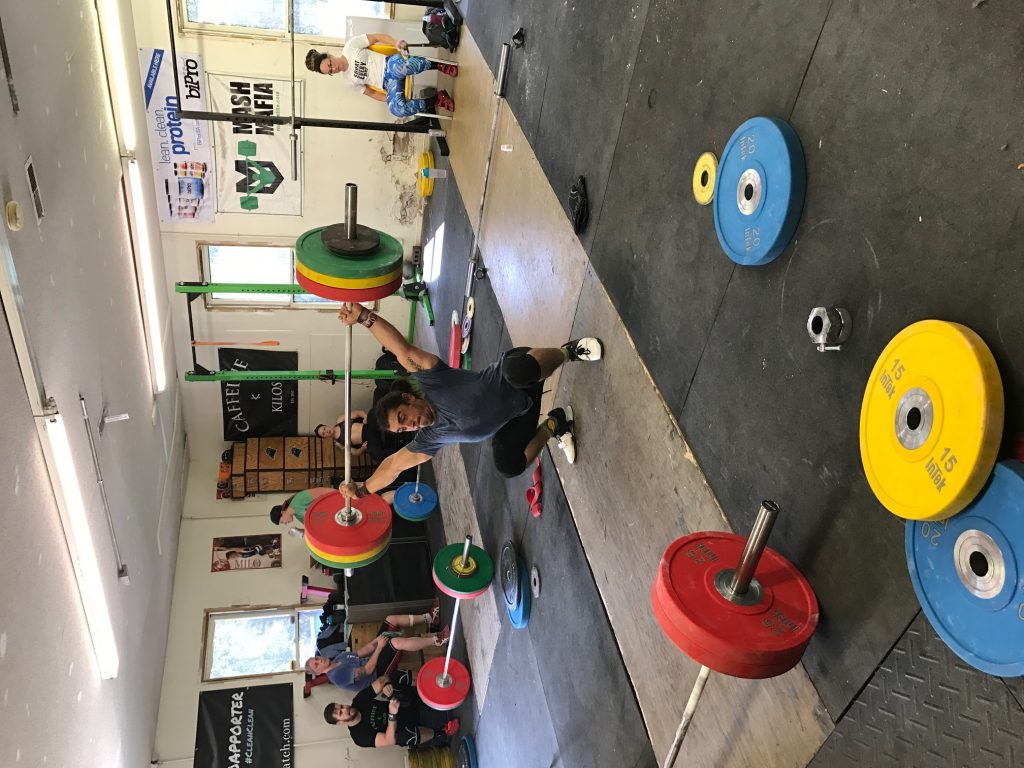Check out one of the Online Teams:
• Mash Mafia Bronze
• Mash Mafia Silver
• Mash Mafia Gold
• Eat What You Want
• Eat and Lift What You Want
Check them out here: ⇒ Mash Mafia Online Teams
===============================================
The Science of Cuing the Snatch
by Coach Matt Shiver, B.S.
The National Strength and Conditioning Association publishes monthly research articles through the Journal of Strength and Conditioning Research. It seems like every month when I sign-in, there is more and more research being done on weightlifting, powerlifting, and CrossFit. This past month they published one of the best research articles yet. The title is “Does Focus of Attention Improve Snatch Lift Kinematics?”.

Of course, being the science nerd that I am, I got really excited and dug into it more. The aim of the study was to look how giving different types of cues changed the performance of the lifts. The article defined cues the following way: “Coaching cues are short verbal instructions used to facilitate learning and performance”.
The article reports two main types of cues, internal and external cues. Internal cues are cues that cause the athlete to focus on their own body segment movement during the repetition (elbows, knees, ankles, hips, etc.) External cues are cues that make the athlete focus on the performance of the movement. These include cues like “push through the floor”, “punch through the ceiling”, or “rip the head off a lion”.
Many weightlifting coaches cue internally. It makes the most sense when we are trying to fix one small segment of the athlete’s movement. We can focus on the hips, the elbows, the shoulders, etc. Bob Takano is quoted saying “In all movements, it is essential to emphasize the movement of the body parts, rather than the moving of the bar”. This study was done to put that concept to the test.
We know from other sport performance and motor learning literature that external cues are typically always more effective. They lead to improved performance and faster motor learning of new skills. “Wulf and Dufek contend that an internal focus of attention effectively “freezes” the body’s degrees of freedom”. Meaning, all the attention goes to just that one area, and the rest of the body doesn’t move like it should. It interferes with the timing of the rest of the movement.
The study consisted of 12 weightlifting athletes with an average of 3.13 years of training experience. Each athlete had a total of 6 snatches at 80% of their 1RM. 3 of the snatches were given an internal cue and the other 3 were given an external cue. The internal cue was “bring the elbows up and to the side”. The external cue was “bring the barbell up and back”.

What the study found was that internal cues increased the elbow velocity speed but it increased the angle at which the barbell was at during the barbell’s peak height. This increased angle caused the athlete to pull under the barbell too early. Thus, throwing off the timing of the snatch.
The study found that external cues kept a smaller angle at the peak height of the pull and it increased the horizontal velocity of the barbell. The horizontal velocity of the barbell was the speed at which the bar was pulled back from the floor, into the hips, and then back overhead. This showed to improve the angles and timing of the snatch.
The vertical barbell velocity was not changed by either condition.
In conclusion, the authors of the study encouraged coaches to use more external cues as opposed to the use of internal cues when coaching the snatch. They believed that due to the improved body angles and horizontal velocity of the barbell, the snatch was performed better using external cues.
Using external cues are hard! It is easy to tell someone to extend at the knees more or pull higher with their elbows. The challenge becomes to be creative enough to get the athletes to do what you want them to do joint by joint, without giving them just one joint to think about. Cueing can separate a good coach from a great coach. My best piece of advice for getting better at cueing is spending time around good coaches. Take some cues from them, but also start trying to be creative and try making your own. There are no right or wrong cues. Everyone responds to cues differently, it’s all about finding the cues that your athletes will respond to best.
I’ve attached the abstract to the article listed below. Give it a look over!
Abstract: http://journals.lww.com/nsca-jscr/Abstract/2017/10000/Does_Focus_of_Attention_Improve_Snatch_Lift.14.aspx
About the Author:
Matthew Shiver, CSCS, SPT
Current Doctor of Physical Therapy Student at Duke University. Graduated from Appalachian State University with a Bachelor’s Degree in Exercise Science and Minor in Nutrition Studies. Co-Founder of Appalachian State’s Mountaineer Weightlifting Club. Olympic Weightlifting Coach at Bull City CrossFit. NSCA – Certified Strength and Conditioning Specialist.
================================================
Check out one of our Eleven E-Books:
• “Squat Every Day” (High Frequency Squat Programming)
• “Eat What You Want” (Nutrition, Macros, and a built-in Macro Calculator
• “Squat Every Day 2” (Part 2 of High Frequency Squat Programming)
• “No Weaknesses” (Defeat Muscular Imbalances crush the Recovery Game)
• “Mash Program Sampler” (Athletic Performance, Oly, Powerlifting, and Functional Programming)
• “Mash Program Sampler 2 (8 More 12-week Programs)
• “The Mash Blueprint for Program Design” (Learn all about Programming)
• “Performance Zone” (Defeat all Mental Roadblocks)
• “Train Stupid”(Programming and Philosophy of Nathan Damron)
• “MashJacked” (Hypertrophy for Performance and Aesthetics)
• “Conjugate: Westside Inspired Weightlifting”
Check them out here: ⇒ Mash Elite E-Books

The study referenced in this article included 12 weightlifters. Do you know of any studies where a larger number of participants was used and if so, were the results consistent?